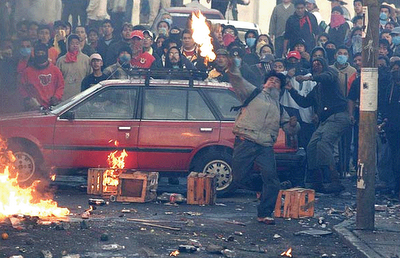
Despite receiving no coverage in the US, a bloody drama is unfolding south of the border. In the current Latin American climate of a radicalized mainstream and against a local backdrop of a hotly contested election and the Zapatistas' "other campaign" a small Mexican town has exploded in violence.
On May 3rd state police attacked unlicensed street vendors in the town of Atenco. The vendors had ignored police warnings and counted on support from local land rights activists to resist the police. What began as a pretty standard state-vs.-squatters type struggle escalated into a mini-revolution as the activists defeated the initial police assault. Mainstream press accounts state some fifty cops were injured, one gravely, and six were taken hostage. The hostages were later released to the Red Cross, but the police ratcheted up the violence in "retaking" Atenco -- they turned the situation into a bloodbath by basically attacking the general population of the town.
Three-thousand police reportedly executed a house to house sweep, smashing windows and breaking down doors. Foreign journalists were beaten and later deported, and two dozen detained women report rapes and sexual abuse. The BBC reported "television images of police beating bound demonstrators." Quetzal Belmont writes in NarcoNews of "200 people arrested; others beaten, injured, and disappeared; and the death of 14-year-old Javier Cortés", of a 20-year-old economics student now in a coma, and compares the situation to a witch hunt.
Spanish human rights activist María Sastres described the assault as follows:
We came to Mexico to work with indigenous communities in Chiapas, and later joined the Other Campaign, to work as human rights observers and photographers. When we found out what was happening in Atenco, we went there. We arrived at night and saw that the town was already surrounded by barricades. The police entered at about 6:00 AM. [...]
There were 3,000 police, and there were 300 of us. They came after us with everything: tear gas, bullets, everything. We ran all over town, trying to get away from the police, but there wasn’t a single street without police. But finally, a woman opened her door and let us hide in her house with eight other people.
[After hiding in the woman's house for two hours] We could hear that the police were starting to bang on doors, supposedly looking for the police who had been taking hostage. That’s how they finally found us and grabbed us. They pushed our faces into the dirt. They covered our faces with hoods, and they bound our hands right there in the yard. They were asking for our names, they recorded us on video, and that’s when the first insults and beatings began.
While the mainstream press blames the violence on the Zapatistas; for example, a Houston Chronicle editorial informs us,
Since last week, when Spanish-language television aired extensive, horrifying footage of the violence, Mexicans have been trying to work out where this event fits in a country in which political violence has faded. The short answer may lie in nearby Mexico City, where 1990s rebel leader Subcomandante Marcos arrived for a May 1 march that may have inspired the vendors and their friends to riot.
Simon Fitzgerald of La Luchita places Atenco in context in a less biased and cartoonish manner:
Why in San Salvador Atenco?
The populace of the area had already been radicalized and organized in 2002 when the local, state and federal governments wanted to confiscate the farmlands of Atenco in order to build a new airport for Mexico City. During that fight, the people waged a popular campaign of struggle when it became clear that all three levels of government were colluding against them. Their marches, yielding machetes as symbols of their rural labor, were met with police violence. After police detained, beat and arrested marchers, one slipped into a coma and died from lack of treatment in police custody.
Narco News has a two part series on the 2002 confrontations here and here. There is also a video at Salon Chingon.
Furthermore, activists from Atenco had been participating in the Zapatista's "Other Campaign," the attack on the vendors (who are becoming an important yet marginalized part of the new "post-Fordist" economy and have been important in other political organizing such as the Bolivian uprising that swept Evo Morales into power) came as Marcos was arriving in Mexico City.
While the Zapatistas' spokesperson Marcos (or Delegate Zero) is promising to remain in Mexico, D.F. until the detained people of Atenco are freed (even if it keeps him there through the elections). Meanwhile mass media like the BBC areforecastingg more election violence based on the Atenco experience.
While perhaps attempting to marginalize the "Other Campaign," the Mexicangovernmentt may be giving it legitimacy. As the Zapatistas call for all of its supporters to open a campaign of non violent resistance on behalf of the people of Atenco, there actions may be winning them alliances and earning them relevance beyond theindigenouss enclaves of rural Chiapas.
